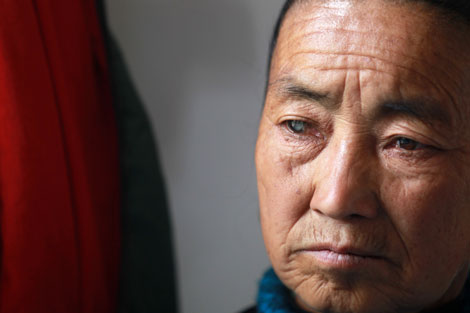Full text: White paper on rural poverty reduction
Updated: 2011-11-16 14:39
(Xinhua)
|
|||||||||
III. Special Poverty Reduction Programs
The Chinese government aims its poverty reduction programs at all people whose income is below the poverty line, while putting emphasis on the old revolutionary bases in the central and western regions, areas inhabited by ethnic minorities, border areas and destitute areas. It includes 592 counties in these areas in the key programs of the nation' s poverty reduction effort. The central government and local governments at all levels formulate special programs, appropriate special funds and concentrate resources to improve infrastructure construction, develop specialty and competitive industries, improve social services and enhance the people's quality in these areas. The local governments of other impoverished counties, townships and villages in the eastern, central and western regions are mainly responsible for their respective poverty reduction programs.
Over the past ten years, the central and local governments have been constantly adjusting their structures of financial expenditure and gradually increasing the financial input into poverty reduction programs. The financial input increased from 12.75 billion yuan in 2001 to 34.93 billion yuan in 2010, with an average annual growth rate of 11.9 percent, and the accumulative input totaled 204.38 billion yuan in these ten years. For a breakdown, funds appropriated by the central government for poverty reduction programs increased from 10.002 billion yuan in 2001 to 22.27 billion yuan in 2010, with an average annual growth of 9.3 percent, and the accumulative input reached 144.04 billion yuan over these ten years. The distribution of poverty relief funds reflected the priority principle. The accumulative financial input to the key counties in the national and provincial development-oriented poverty reduction programs over these ten years reached 145.72 billion yuan, accounting for 71.3 percent of the total input and with the average in-put for each county reaching 136 million yuan; the central government appropriated a total of 135.62 billion yuan for poverty reduction in 22 provinces (autonomous regions and municipalities directly under the central government), including 87.7 billion yuan for 12 provinces (autonomous regions and municipalities directly under the central government) in the western regions.
Implementing comprehensive development-oriented poverty reduction in villages. To promote overall economic and social development in poverty-stricken areas, the state designated 148,000 impoverished villages nationwide in 2001, and formulated poverty reduction programs for each and every village covering basic farmland, drinking water for people and livestock, roads, income of poor villagers, social undertakings and other areas. The government pooled and allocated funds for the implementation of the programs on a yearly basis to increase the income of impoverished people, upgrade infrastructure, develop public welfare, and improve the production and living standards. By the end of 2010, some 126,000 villages had implemented the programs, and the villages in old revolutionary bases, areas inhabited by smaller minority groups and border areas had basically completed the work.
Strengthening training of the labor force. The development of human resources is an effective means of enhancing development capability. Since 2004, the central government has appropriated a total of three billion yuan in poverty reduction funds for the "Dew Program," which focuses on training labor force from poor rural families in technical skills and practical agricultural techniques so that they can find better-paying jobs. By the year 2010, more than four million people from poor rural families had received such training, and 80 percent of them found jobs outside agriculture. A sample survey revealed that workers who had received training earned 300-400 yuan per month more than those who hadn't. The training programs not only helped employment and salary growth in poor areas, they also provided chances for the workers to get access to new skills and new concepts, thus broadening their horizons and enhance their confidence. In 2010, in an attempt to promote employment the state began to carry out a pilot project that provides direct subsidy for high-school graduates from poor families to pursue vocational education.
Poverty reduction through education. Over the past decade, the state has been vigorously developing education, helping large numbers of students from economically poor rural families acquire necessary skills through vocational education and find stable employment in cities/towns, thus shaking off or alleviating poverty in these families. From 2001 to 2010, some 42.89 million students graduated from secondary vocational schools, and most of them were from rural families or impoverished urban families. The state constantly improves the subsidy system for poor students in compulsory education, senior high school education and higher education to relieve the financial burden on poor families. The government also builds schools for immigrants, and encourages immigration for ecological protection purpose.
Promoting poverty reduction with industrialization. Combining such programs as comprehensive promotion of poverty reduction in villages, experimental development of adjacent areas, poverty relief through science and technology, rendering support to impoverished farmers, constructing industrial bases, encouraging the use of advanced equipment and technologies in agricultural production and developing the rural cooperative economy of scale, China has endeavored to enhance the efficiency and specialization of industrial development in poverty-stricken areas. Over the past decade, the state has helped the poverty-stricken areas develop potato cultivation, economic trees and fruits, grassland husbandry, cotton planting and other leading industries. Of them, potato production and processing has become a special and competitive industry for the poor areas to guarantee food security, ward off droughts and other natural disasters and get rid of poverty.
Implementing work relief. The work-relief policy was initiated in the 1980s in rural areas to mainly support economic development in poverty-stricken areas and the construction of small-scale infrastructure projects in rural areas related to poverty reduction, including building of roads in counties, townships and villages, works of farmland irrigation, drinking water projects for the people and livestock, basic farmland capital construction, grassland construction, comprehensive improvement of small river basins, etc. From 2001 to 2010, more than 55 billion yuan was earmarked by the central government as work-relief funds, effectively improving the production and living conditions in poverty-stricken areas.
Relocating impoverished populations from environmentally unfriendly areas. The voluntary relocation of impoverished populations from areas with harsh living conditions and natural resource-poor areas is an important way to improve their living environment and development conditions. By 2010, the Chinese government had relocated 7.7 million impoverished people, effectively improving their housing, communications, power supply and other living conditions. In the process of advancing industrialization and urbanization, some impoverished areas have combined such poverty-relief relocation with the construction of county seats, central towns and industrial parks, converting cultivated land back to forests and grasslands, migration for ecological purpose, merger of villages and disaster prevention, in an effort to improve public services for these people while promoting the employment of impoverished farmers in urban areas and sectors outside agriculture.
Financial poverty reduction. Shortages in funds have always been an important factor holding back the survival and development of the poor. Since 2006, the state has tried out an experimental mutual funding program in 13,600 impoverished villages, allocating 150,000 yuan to each of the villages to support local production in line with the principles of "owned by the people, used by the people, managed by the people, enjoyed by the people, cyclical usage and spiral development," thus establishing a long-term working mechanism for the use of the fund. China has also carried out reforms in interest discounts for poverty-relief loans in an effort to guide and inspire financial institutions to grant more loans of interest discounts. From 2001 to 2010, the central government appropriated in total 5.415 billion yuan of poverty reduction funds with discount interests, and granted nearly 200 billion yuan of poverty reduction loans. The comprehensive reform of the state administrative system of poverty reduction loans in 2008, in particular, further motivated local governments and financial institutions to engage in development-oriented poverty reduction, and effectively helped needy people to get such loans by introducing the market competition mechanism, expanding the operational authority of the loan-issuing bodies, and delegating greater power to lower levels in the management of interest-discounted funds, among other measures.
Pilot projects of poverty reduction in special areas. In order to solve major problems hindering the development of poverty-stricken areas, the Chinese government carried out development-oriented poverty-relief work in some special areas in light of the local characteristics. The following are some of the examples: major infrastructure construction projects in Donglan County, Bama County and Fengshan County in the Guangxi Zhuang Autonomous Region; a pilot project combining development-oriented poverty reduction with the comprehensive prevention and control of Kaschin-Beck Disease in the Aba Tibetan and Qiang Autonomous Prefecture in Sichuan Province; a pilot project combining poverty reduction with ecological construction in the rocky desert areas of Qinglong County in Guizhou Province; a pilot project of poverty reduction in the border areas of Akqi County in the Xinjiang Uygur Autonomous Region; a comprehensive poverty reduction program for the Blang ethnic group and the mountain tribes of the Yao ethnic group in Yunnan Province; and the combination of post-quake reconstruction with disaster prevention and reduction of impoverished areas in the quake-stricken Wenchuan of Sichuan Province and Yushu of Qinghai Province to promote their post-quake reconstruction in an all-round way. Through these pilot projects, the state explored the paths and accumulated experience for poverty reduction work suited to local conditions.











